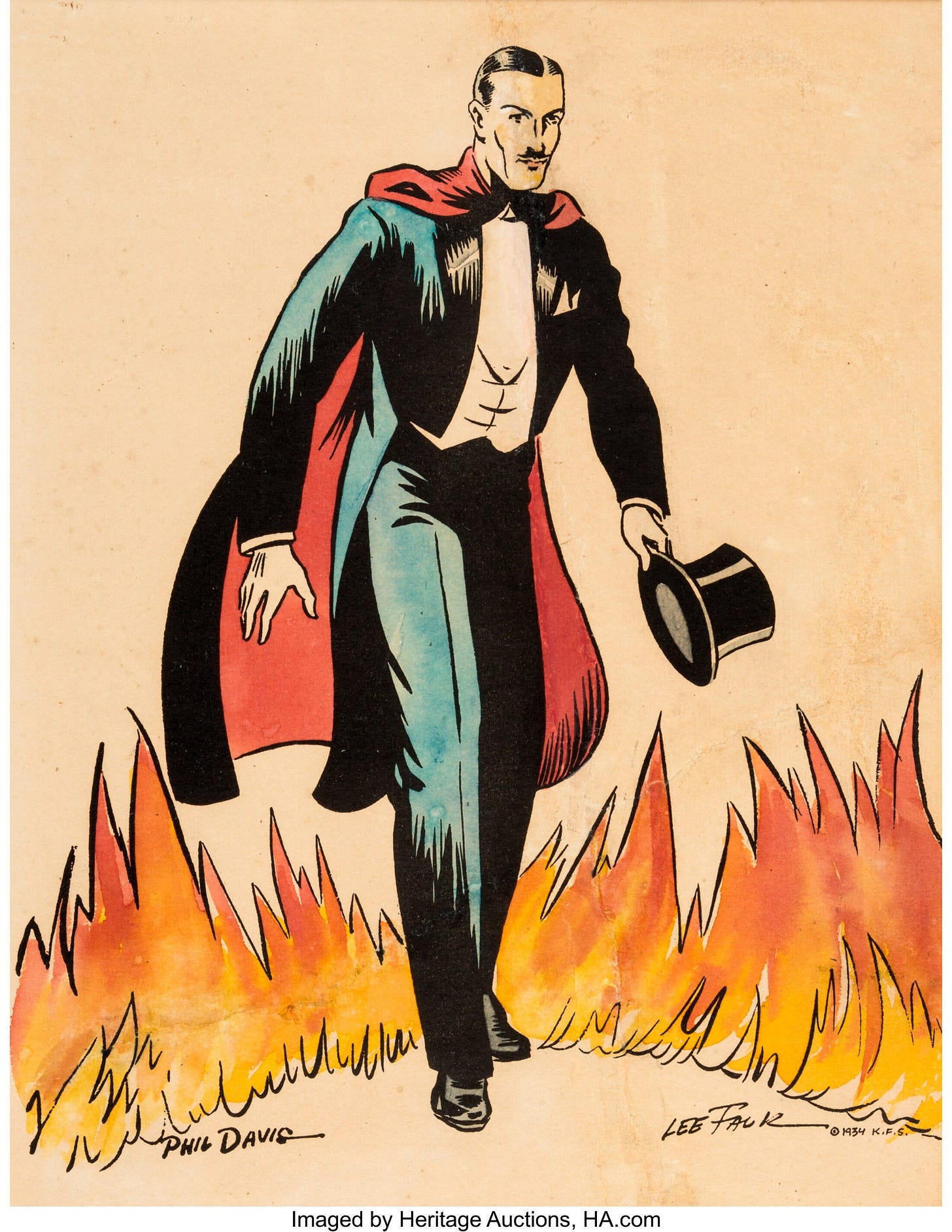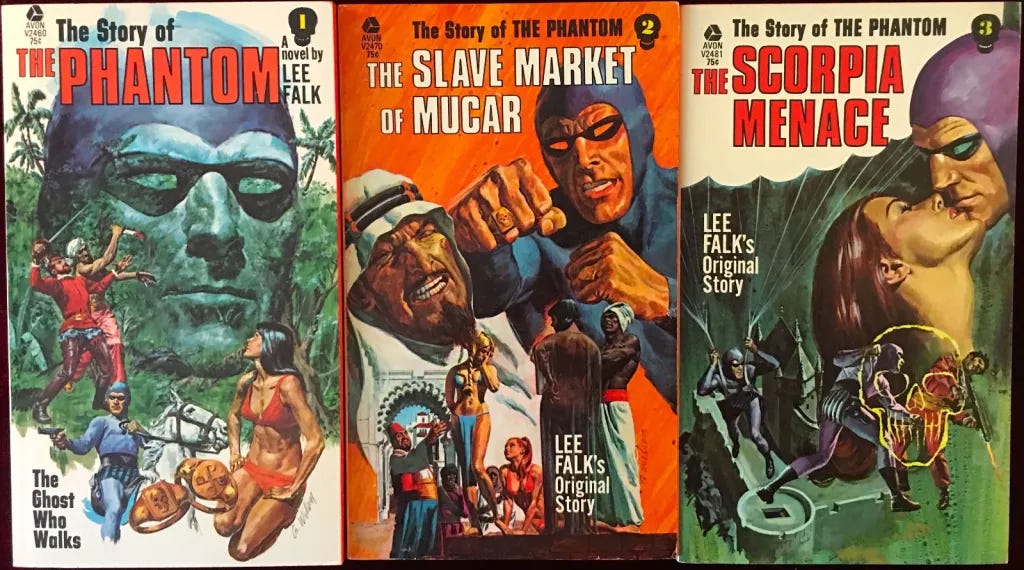Recently, while spending some quality time with my family deep in the sticks, I perused the local rag that pretends to be a newspaper. There, buried deep behind advertisements and editorials written by semi-notable pundit types, I found the comics section. Comic strips are still being written. That in and of itself is incredible. As a young pup, I used to steal my dad’s newspaper and discard everything but the comics. The political stuff and the humor stuff was all well and good, but I preferred the action and mystery comic strips. My favorite then and now is The Phantom, and it pleases me to no end that the comic strip is still running.
Known as “The Ghost Who Walks,” The Phantom is yet another masked crimefighter in the mold of The Shadow or The Phantom Detective (the latter wore a similar domino mask while fighting mostly Chinese criminals in the 1930s). As such, when the character debuted in American newspapers on February 17, 1936, he was far from a novelty. But this fact does not diminish the genius or enjoyability of the character, nor does it cheapen the efforts of The Phantom’s creator, Lee Falk.
Falk was born Leon Harrison Gross on April 28, 1911, in St. Louis, Missouri. Gross combined a childhood nickname with his stepfather’s surname to create his famous pseudonym. Falk seems to have been a precocious youth with interests in literature, especially Shakespeare, and magic. Falk edited his high school paper, then, while attending the University of Illinois as a literature student, he submitted articles, short stories, and poetry to the college newspaper. Not satisfied with these contributions, the undergraduate Falk envisioned a comic strip character. Falk began sketching the character’s background and even inked early iterations of what would become his first popular character: Mandrake the Magician.
First seeing publication as a comic strip in June 1934, Mandrake the Magician is an expert of hypnosis, invisibility, and other supernatural powers who fights both human criminals and otherworldly entities. The character and his comic strip proved to be a major hit for Falk, and Mandrake the Magician still appears today in international newspapers and in American comic books. Despite this success, Falk did not yet devote himself entirely to writing. Falk took a high-paying position with a St. Louis advertising agency. It was there that he dreamed up his next creation.
The Phantom debuted when Falk was only twenty-five. At first, The Phantom had a somewhat pedestrian origin story. Jimmy Wells, a wealthy playboy with a thirst for justice, wore the purple and black to attack criminals at night. Such an origin story has been repeated numerous times, and was, in 1936, synonymous with The Shadow. The ever-innovative Falk decided to change things a few months into the comic strip’s original run. Rather than just another urban crimefighter, The Phantom was moved to the jungles of Africa, specifically the fictional East African nation of Bangalla (sometimes spelled as Bengalla). A former British colony with links to the Red Sea (and thus Asia), Bangalla is a democracy constantly threatened by military and criminal warlords who resort to gross acts of violence in order to undermine the government. The Phantom is the great protector of Bangalla’s government and her people. While a man, The Phantom is also an ideal and a bloodline legacy, as the first Phantom swore the Oath of the Skull in 1536 after surviving a horrific pirate attack. That Phantom, Christopher Walker, took refuge in a cave (dubbed Skull Cave), which would later become The Phantom’s secret lair and HQ.
The Phantom that we know and love today is the twenty-first Phantom. This was laid out in a 1973 pulp novel written by Falk that was published by Avon Books. In The Story of the Phantom, the masked crimefighter is revealed to be Kit Walker, a Bangalla native who received his education in Missouri. Walker is a sportsman with expertise in boxing and other martial arts. Like all other wearers of the domino mask, Walker is proficient with the pistol, favoring the trademark Colt .45. The Avon novels ran from 1972 until 1975, and featured The Phantom duking it out with gangsters, Soviet spies, and even a vampire. As in the comic strips, The Phantom’s chief antagonists in the novels remain the nefarious Singh Brotherhood. Besides pulp novels, The Phantom has left the confines of the comic strips to appear in film serials and one very disappointing feature-length film in 1996.
For such a nominally trite character, The Phantom continues to enjoy life, albeit in a capacity far more limited than many other pulp heroes. Still, it is safe to say that Falk’s creation has already entered the realm of immortality. He remains a popular hero internationally, with Sweden being particularly crazy for The Phantom and his propensity to drink milk. The Phantom also deserves credit for being highly innovative and inventive. The Phantom was the first hero to wear skin-hugging spandex, plus his lack of pupils, which was inspired by Falk’s admiration for Greek and Roman statues, created the distinctive look of comic superheroes. The Phantom, alongside The Shadow, helped to spawn an entire genealogical line of superheroes and masked vigilantes. No Phantom, no Batman. Simple, really.
So, the next time you find yourself with nothing to do, locate a local paper and flip to the comics section. I’ll bet you will find a Phantom adventure waiting for you. As for me, one of my resolutions for 2023 will be to read more Phantom publications. I think that shall prove easier to do than losing weight or quitting booze.







The first few of the novels are available on Kindle Unlimited.